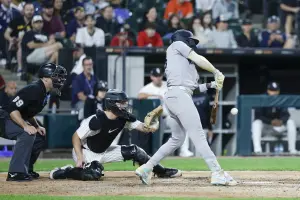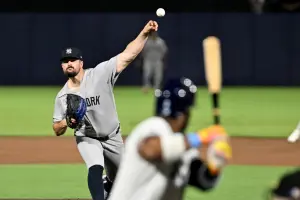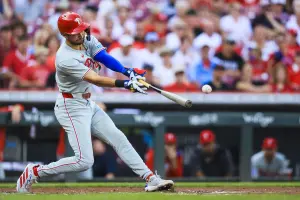
(*) F/F SPOTLIGHT: Jorge Soler
Each year in The Baseball Forecaster, we publish the “A-Rod 10-Step Path to Stardom”. It’s a long path, filled with ups and downs, that a top prospect might take before it all clicks at the MLB level. In short, said prospect arrives to the majors with plenty of hype, struggles and gets sent down, dominates the minors again, gets recalled and struggles; rinse and repeat. Then we get to Step 8:
Step 8. The media turns their backs. Fantasy leaguers reduce their expectations.
Jorge Soler (OF, KC), circa March 2018? Definitely at Step 8.
Soler was an 8A prospect in our Cubs 2015 Org Report—ranked ahead of names like Addison Russell, Kyle Schwarber, Eloy Jiménez, and Gleyber Torres—as a 23-year-old who “exudes athleticism and is just starting to tap into his potential”. The hype was real, but as his Average Draft Position (ADP) shows, the market has since soured on Soler:
Year ADP ==== === 2015 102 2016 249 2017 304 2018 377
And who could blame us? After a superb—yet brief—2014 cameo, Soler had shown next to nothing in the majors heading into this season:
Year AB BA/xBA bb% ct% GB/LD/FB h% HctX PX/xPX hr/f BPV ==== === ========= === === ======== == ==== ======= ==== === 2014 89 .292/.302 6 73 52/12/36 35 127 215/131 21% 110 2015 366 .262/.236 8 67 42/28/30 37 106 107/122 14% 2 2016 227 .238/.234 12 71 40/17/43 28 90 125/ 91 17% 36 2017 97 .144/.186 11 63 38/18/44 20 79 88/ 88 7% -29
A BaseballHQ.com subscription unlocks articles like these all season long. Get the edge for 2018 in your league! Subscribe to BaseballHQ.com.
Things have taken a surprising this year, as Soler's suddenly slashing .297/.415/.505 with 4 HR through his first 29 games.
Year AB BA/xBA bb% ct% GB/LD/FB h% HctX PX/xPX hr/f BPV ==== === ========= === === ======== == ==== ======= ==== === 2018 101 .297/.246 16 70 44/17/39 39 117 145/ 94 14% 57
We're seeing some noteworthy shifts in Soler’s underlying skills:
- Soler’s flashing elite plate patience (bb%), while ct% shows concurrent growth in his bat-to-ball skills.
- HctX suggests the quality of contact has improved as well. Not only is Soler making more contact, but he’s squaring it up more often.
- That said, xPX questions just how much the power has developed. More on this later.
- A sky-high h% won’t last and xBA doesn’t fully believe in the BA gains, but BPV sums things up well: Soler’s early-season burst comes with plenty of skill support.
While a traditional Facts/Flukes analysis might wrap things up with cautious optimism, Soler's prospect pedigree and plate skill overhaul warrant a deeper look. So we’ll dive into Soler’s improved plate skills, see how that relates to harder contact, and look for any reasons to pause as we find out if the hot start is sustainable.
1) A revamped plate approach
“Almost every at-bat, I'm 1-2, 2-2. I'm very proud of that", Soler said in an April 30 article about his early success. In addition to working with a private swing coach this offseason, Soler has been studying pitcher tendencies via an iPad loaded with scouting reports and video. "I kind of know what the pitcher is going to do with me, which isn’t something I did before".
It's tough to quantify just how much this prep work has helped, but the numbers reflect a drastically improved plate approach from Soler in 2018. Here’s a quick refresher on some key plate control metrics we’ll use in this analysis (data from BaseballSavant.com and FanGraphs.com):
Chase%: Percentage of pitches a batter swings at outside the strike zone. (MLB average: 29.6%)
Zone%: Percentage of pitches a batter sees inside the strike zone (43.6%)
SwK%: Swinging-strike percentage (10.6%)
P/PA: Pitches per plate appearance
Year Chase% Zone% SwK% P/PA ==== ====== ===== ==== ==== 2015 30.1 46.5 15.4 4.0 2016 24.0 46.6 14.2 4.0 2017 22.6 46.5 13.5 4.0 2018 21.4 42.2 12.6 4.3
Some things to key on:
- Soler’s not whiffing as often, which helps explain his ct% rebound. The swing-and-miss is more frequent than average, but it's well shy of "red flag" status in today's strikeout-fueled environment.
- Soler's not seeing as many pitches in the strike zone, and he’s simply not chasing them as often.
- Backing up Soler's quote above, he's indeed seeing more pitches per plate appearance.
Looking at Soler’s plate discipline graphically, we can see his swing rates by sections of all hitting zones (courtesy of BrooksBaseball.net). Take particular note of balls below the strike zone, highlighted in yellow:
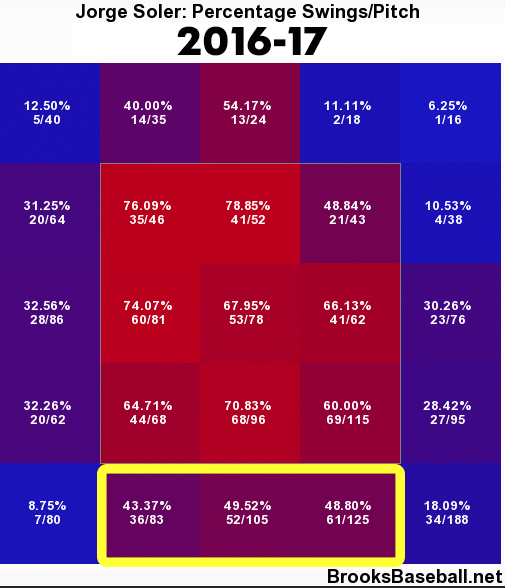
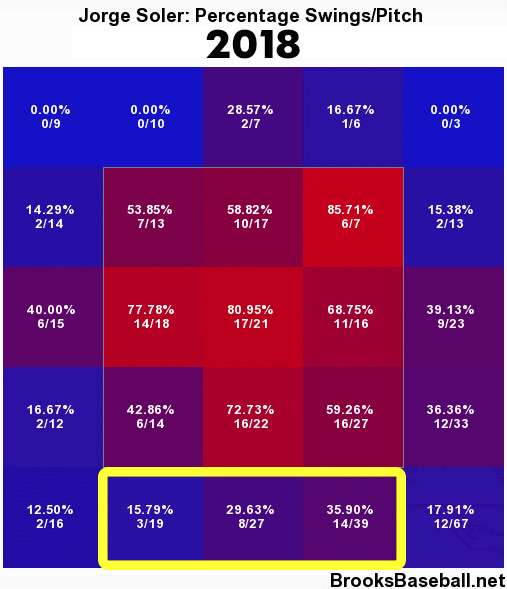
With fewer whiffs, more pitches per plate appearance, and a lower chase rate, Soler has taken tangible steps to be a more selective hitter. It's not only driving bb% and ct% growth, but it might also be behind his early power spike.
2) The power gains
Let's now overlay that yellow zone against Soler's career Isolated Power (ISO), which is a simple measure of power (SLG - BA). For context, the MLB average ISO is .159:
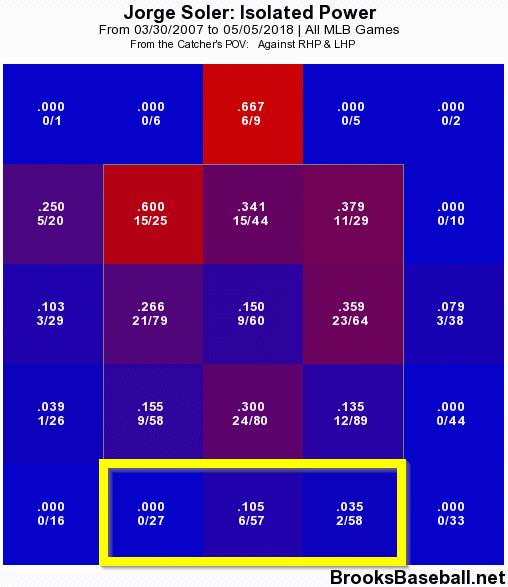
It's safe to say that Soler has been a weak low-ball power hitter, but he's been able to minimize bad contact by laying off balls low in the zone this season. ISO isn't an ideal power metric—it's based on results rather than skill—so let's cross-check his power gains against some of our favorite raw skill metrics:
Year PX/xPX FB% HH% 95+%* ==== ======= === === ===== 2015 107/123 30 38 43.1 2016 125/ 91 43 31 36.0 2017 88/ 88 44 31 34.4 2018 145/ 94 39 43 42.3 *95+%: Percent of batted balls with >95 mph exit velocity
Most of these metrics agree—Soler's power growth seems legit:
- His hard-hit rate (HH%) has surged to what would be a career high, and it's backed up by Statcast's 95+% metric.
- We’re not overly concerned with the PX/xPX gap at this point; it’s more a product of lower trajectory than weaker contact. A couple FB% ticks toward 2016-17 levels would close the gap quickly.
Soler’s pitch selection and power gains seem to go hand-in-hand. He’s making harder contact and laying off pitches outside his wheelhouse, which has led to improved plate skills and enhanced his raw power.
3) Reasons for pause
While Soler's new plate approach has been a welcome change, remember that 1) we’re still in small-sample mode, and 2) MLB pitchers always adjust.
We mentioned Zone% earlier in this piece, as Soler has seen fewer pitches inside the strike zone. Here are his pitch location heat maps from 2016-17 vs 2018, courtesy of BaseballSavant.com:
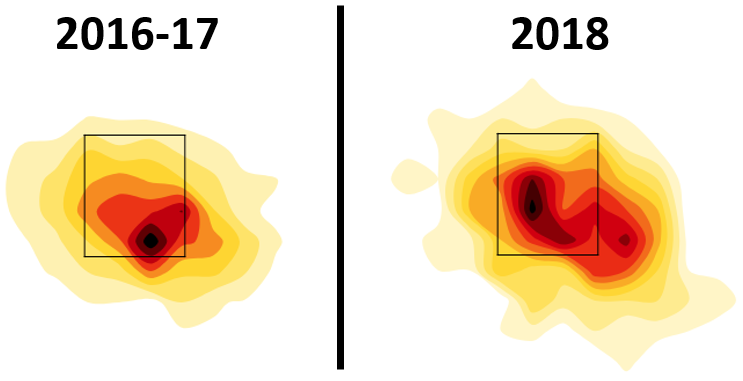
Note the dark-red area low in the strike zone through 2016-17, Soler's worst two seasons as a pro. Not the case in 2018. When pitchers are hitting the zone against Soler, it's been up, and he's making them pay. Expect to see more pitchers challenge Soler early in the count, focusing low in the zone to combat his plate patience and low-ball soft spots.
And Soler's gains have come solely against left-handed pitching, which has always been his strong suit. He's not at risk of a platoon, but a quick glance at his L/R splits suggests there's still work to do vs. RHP:
vs RHP AB ct% OPS PX HH% | vs LHP AB ct% OPS PX HH% ====== === === ==== === === | ====== === === ===== === === Career 636 69 .727 108 35 | Career 244 67 .819 133 36 2018 64 70 .700 67 33 | 2018 37 68 1.300 286 58
A 58% hard-hit rate and 1.300 OPS against lefties? Fantastic, but also unsustainable. Note the severe power splits (PX, HH%) against right-handed pitching; they've actually gotten worse so far in 2018.
Conclusion
It's only been a month, but Soler's showing glimpses of what made him our #12 overall prospect in 2015. A more patient plate approach has driven legit BA/OBP gains, and he's making harder contact by laying off pitches outside the zone. That said, a full breakout isn't likely until he 1) hits for more power vs. RHP, and 2) can prove he'll be able to handle pitcher adjustments—more strikes lower in the zone—that are likely coming his way.
The A-Rod 10-Step Path to Stardom ends with this:
Step 10. Prospect is promoted in Year 3 and explodes. Some lucky fantasy leaguer lands a franchise player for under $5.
Technically it's Year 5 for Soler, and while things are looking up, we're still not ready to go that far.


